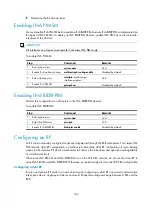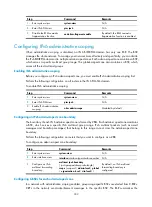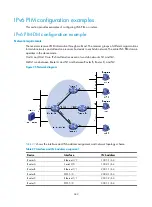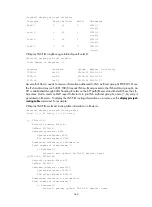
332
Step Command
Remarks
1.
Enter system view.
system-view
N/A
2.
Enter IPv6 PIM view.
pim ipv6
N/A
3.
Disable the BSM semantic
fragmentation function.
undo bsm-fragment
enable
By default, the BSM semantic
fragmentation function is enabled.
Configuring IPv6 administrative scoping
When administrative scoping is disabled, an IPv6 BIDIR-PIM domain has only one BSR. The BSR
manages the whole network. To manage your network more effectively and specifically, you can divide
the IPv6 BIDIR-PIM domain into multiple admin-scoped zones. Each admin-scoped zone maintains a BSR,
which serves a specific multicast group range. The global-scoped zone also maintains a BSR, which
serves all the rest multicast groups.
Enabling IPv6 administrative scoping
Before you configure an IPv6 admin-scoped zone, you must enable IPv6 administrative scoping first.
Perform the following configuration on all routers in the IPv6 PIM-SM domain.
To enable IPv6 administrative scoping:
Step Command
Remarks
1.
Enter system view.
system-view
N/A
2.
Enter IPv6 PIM view.
pim
ipv6
N/A
3.
Enable IPv6 administrative
scoping.
c-bsr admin-scope
Disabled by default.
Configuring an IPv6 admin-scoped zone boundary
The boundary of each IPv6 admin-scoped zone is formed by ZBRs. Each admin-scoped zone maintains
a BSR, which serves a specific IPv6 multicast group range. IPv6 multicast packets (such as assert
messages and bootstrap messages) that belong to this range cannot cross the admin-scoped zone
boundary.
Perform the following configuration on routers that you want to configure as a ZBR.
To configure an admin-scoped zone boundary:
Step Command
Remarks
1.
Enter system view.
system-view
N/A
2.
Enter interface view.
interface
interface-type interface-number
N/A
3.
Configure an IPv6
multicast forwarding
boundary.
multicast ipv6 boundary
{
ipv6-group-address prefix-length
|
scope
{
scope-id
|
admin-local
|
global
|
organization-local
|
site-local
} }
By default, no IPv6 multicast
forwarding boundary is
configured.
Configuring C-BSRs for each admin-scoped zone
In a network with administrative scoping enabled, group-range-specific BSRs are elected from C-BSRs.
C-RPs in the network send advertisement messages to the specific BSR. The BSR summarizes the
















































